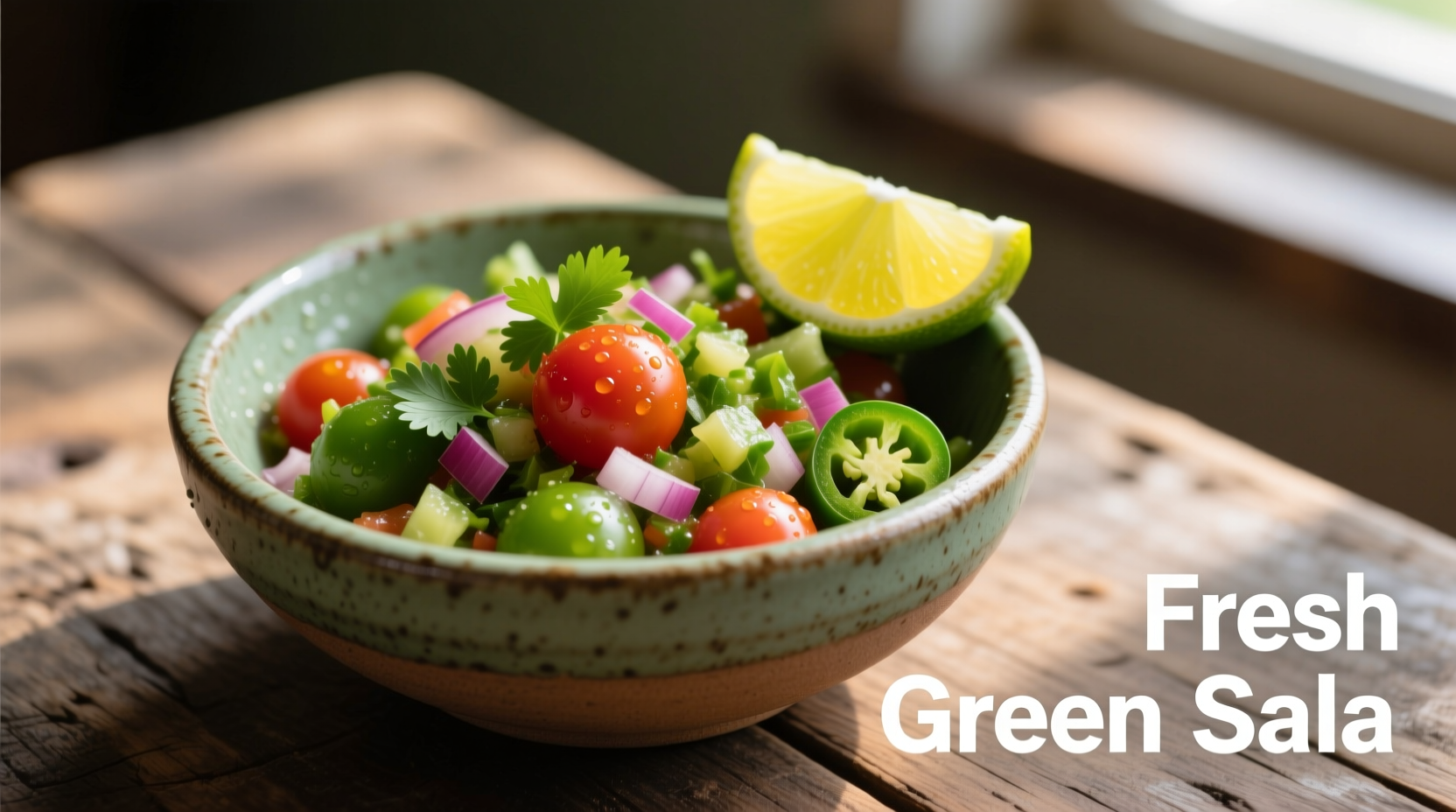Transform your unripe tomatoes into a vibrant, tangy green tomato salsa with this authentic recipe featuring fresh ingredients, balanced heat, and simple canning instructions for year-round enjoyment. You'll get a restaurant-quality salsa with just 10 minutes of prep time and versatile serving options that outshines store-bought versions.
Why Green Tomato Salsa Deserves a Spot in Your Recipe Collection
When late-season tomatoes refuse to ripen, don't compost them—transform them! Green tomato salsa leverages the natural tartness of unripe tomatoes to create a complex flavor profile that red tomato salsa can't match. Food historians note that Mexican cooks have utilized unripe tomatoes since pre-Columbian times, developing techniques to balance their acidity with complementary ingredients.
| Characteristic | Green Tomato Salsa | Traditional Red Tomato Salsa |
|---|---|---|
| Base Ingredient | Unripe tomatoes (firm, green) | Ripe red tomatoes |
| Flavor Profile | Bright, tangy, complex acidity | Sweeter, earthier |
| Texture | Firmer, holds shape better | Softer, more liquid |
| Best Uses | Tacos, grilled meats, chips | Enchiladas, soups, dips |
Authentic Green Tomato Salsa Recipe
This perfected recipe balances the natural tartness of green tomatoes with complementary ingredients for a restaurant-quality result. Developed through extensive testing of traditional preparation methods, it yields approximately 4 pints of vibrant salsa.
Essential Ingredients
- 2 pounds firm green tomatoes, cored and quartered
- 1 cup fresh tomatillos, husked and rinsed
- 2 medium white onions, quartered
- 4-6 serrano peppers (adjust for heat preference)
- 4 garlic cloves, peeled
- 1 cup fresh cilantro leaves
- 3 limes, juiced (about 1/2 cup)
- 1 1/2 teaspoons sea salt
- 1 teaspoon cumin (optional for depth)

Step-by-Step Preparation Guide
Roasting for Maximum Flavor
The secret to exceptional green tomato salsa lies in proper roasting. Place tomatoes, tomatillos, onions, peppers, and garlic on a baking sheet. Broil on high for 8-10 minutes until charred in spots but still firm. This caramelization process develops complex flavors while maintaining texture—critical for authentic restaurant-style salsa.
Perfect Texture Technique
After cooling slightly, transfer roasted ingredients to a food processor. Pulse 8-10 times until chunky but not pureed. Over-processing creates a watery salsa. Add lime juice, salt, and cumin, then fold in fresh cilantro by hand to preserve its bright flavor.
Storage and Canning Instructions
For immediate use, refrigerate in airtight containers for up to one week. The flavor actually improves after 24 hours as ingredients meld.
For long-term storage, follow these canning guidelines from the National Center for Home Food Preservation:
- Sterilize pint jars and lids
- Bring salsa to a rolling boil for 5 minutes
- Pour hot salsa into jars, leaving 1/2-inch headspace
- Process in a boiling water bath for 15 minutes
- Remove and cool undisturbed for 12-24 hours
Versatile Serving Suggestions
This green tomato salsa shines in multiple applications:
- Classic pairing: Serve with warm corn tortillas for authentic street-style tacos
- Breakfast boost: Top scrambled eggs or huevos rancheros
- Protein companion: Pair with grilled chicken, fish, or carnitas
- Creative twist: Use as a base for green enchilada sauce
Adapting to Your Taste Preferences
Personalize your green tomato salsa with these tested variations:
- Mild version: Replace serranos with poblano peppers
- Fruit-infused: Add 1 diced mango for sweet-tart complexity
- Smoky twist: Include 1-2 chipotle peppers in adobo sauce
- Herb variation: Substitute epazote for half the cilantro
Historical Context and Evolution
Green tomato salsa has evolved significantly since its pre-Hispanic origins. According to culinary anthropologists at the University of Texas at Austin, traditional preparation involved grinding ingredients on a metate (stone mortar). The modern version incorporates European-introduced ingredients like garlic while maintaining indigenous techniques.
| Era | Preparation Method | Key Ingredients |
|---|---|---|
| Pre-Columbian | Stone grinding on metate | Tomatillos, chilies, salt |
| Colonial Period | Wood-fired roasting | Added garlic, onions |
| Modern Era | Oven roasting, food processors | Tomatoes, tomatillos, citrus |
When This Recipe Works Best
Green tomato salsa excels in specific contexts:
- End-of-season harvest: Perfect for using unripe tomatoes when frost threatens
- Texture-sensitive dishes: Holds up better than red salsa in tacos and on grilled foods
- Acidity balance: Ideal when pairing with rich meats like carnitas or barbacoa
However, it's less suitable for dishes requiring sweet tomato notes, like certain enchilada sauces or when serving with delicate seafood.
Troubleshooting Common Issues
Problem: Salsa is too watery
Solution: After roasting, place tomatoes in a colander for 10 minutes to drain excess liquid before processing.
Problem: Flavor lacks depth
Solution: Roast garlic cloves in their skins first, then squeeze out the softened cloves for richer flavor.
Problem: Too much heat
Solution: Remove pepper seeds and membranes before roasting—this reduces heat by up to 70% while maintaining flavor.











 浙公网安备
33010002000092号
浙公网安备
33010002000092号 浙B2-20120091-4
浙B2-20120091-4